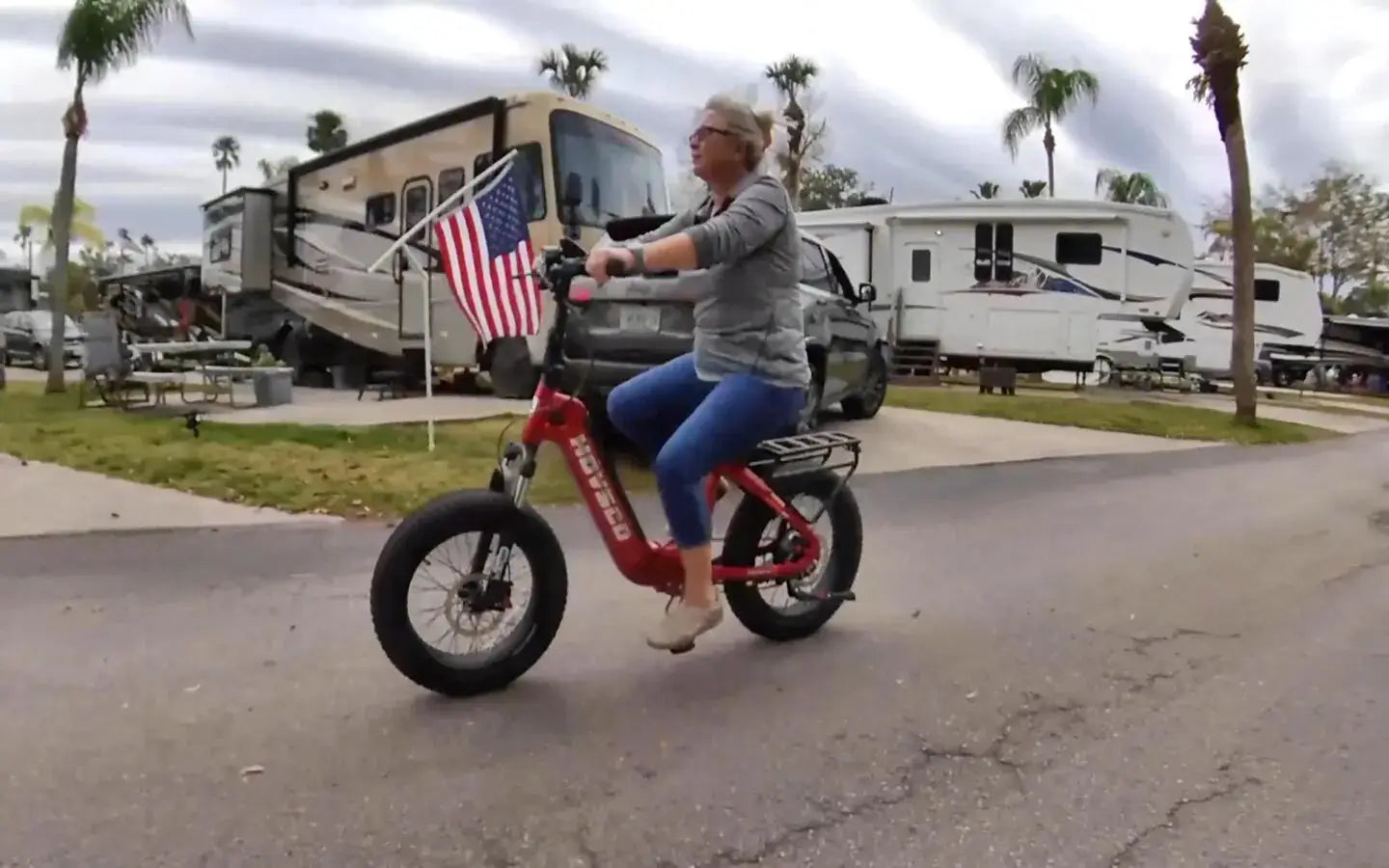
- by LiuJiazhu
Are Fat Tire Electric Bikes Suitable For Off-road Trails?
- by LiuJiazhu
Fat tire electric bikes are excellent for off-road trails due to their wide tires (4"+), which provide superior traction, stability on loose/slippery surfaces, and shock absorption. The motor assists with steep climbs and long distances. However, their heavier weight and lower maneuverability on tight trails can be drawbacks. For sand, snow, or rough terrain, they’re a top choice.
Fat tires excel off-road by distributing weight over a larger surface area, reducing sinkage in sand/snow, and improving grip on rocks/roots. Their low-pressure design (5-15 PSI) absorbs shocks, while the electric motor compensates for added rolling resistance.
Fat tires use widths of 4-5 inches and ultra-low pressure to “float” over soft terrain, unlike traditional mountain bike tires (2-3”). This creates a larger contact patch, enhancing stability on uneven surfaces. For example, a fat tire’s footprint is comparable to a snowshoe, preventing slippage in mud or loose gravel. The motor’s torque (often 80+ Nm) helps overcome the tires’ inherent drag, making steep climbs manageable. Pro tip: Lower tire pressure (8-10 PSI) for maximum grip on technical trails, but avoid going too low to prevent pinch flats. However, what about sharp turns? The wide tires can feel sluggish on switchbacks, requiring wider berths. Still, for most riders, the trade-off in comfort and control is worth it.
Fat tire e-bikes outperform traditional MTBs in sand, snow, or mud but are heavier and less agile on hardpack or technical singletrack. MTBs prioritize speed and precision, while fat e-bikes focus on versatility and comfort.
Traditional mountain bikes with 2.5” tires and suspension systems are built for speed and agility on hardpack trails. In contrast, fat tire e-bikes act like off-road SUVs—slower but unstoppable in extreme conditions. For instance, a 750W mid-drive motor can power through 12” snowdrifts where even a 29” MTB would stall. However, the fat bike’s weight (60-70 lbs vs. 30 lbs for MTBs) makes lifting over obstacles tougher. Pro tip: Choose a fat e-bike if you ride mixed surfaces (e.g., beach-to-forest trails) but stick to an MTB for competitive downhill runs. Ever tried cornering at speed on a fat bike? It’s like turning a bulldozer—stable but not nimble.
| Feature | Fat Tire E-Bike | Traditional MTB |
|---|---|---|
| Tire Width | 4-5" | 2.2-2.5" |
| Best For | Sand, snow, mud | Hardpack, technical trails |
| Weight | 60-70 lbs | 25-35 lbs |
The electric motor compensates for fat tires’ rolling resistance, providing torque for steep climbs and reducing rider fatigue. It extends range, letting riders tackle longer, more challenging trails without exhaustion.
Mid-drive motors (e.g., Bosch Performance Line) are ideal for off-road fat bikes, offering 85+ Nm torque to conquer 20%+ inclines. The motor’s power delivery is adjustable—Eco mode saves battery on flat sections, while Turbo mode engages full torque for log hopping. For example, a 750W motor paired with a 720Wh battery can sustain 40+ miles of trail riding. Pro tip: Use pedal assist Level 1-2 on descents to conserve battery; the motor’s drag-free design won’t slow you down. But what about overheating? Quality motors have thermal sensors to prevent burnout during prolonged climbs. Think of it as a turbocharger: it gives you extra power when needed but relies on smart management to avoid breakdowns.
Weight and maneuverability are key drawbacks. Fat e-bikes are harder to lift over obstacles, slower on packed trails, and consume more battery due to tire drag. Tight switchbacks also require wider turns.
A typical fat tire e-bike weighs 65 lbs—nearly double a standard e-MTB. This affects portability (e.g., loading into a truck) and acceleration. The tires’ width also increases rolling resistance, draining batteries 20-30% faster than slim-tire e-bikes. For instance, a 720Wh battery might last 40 miles on a fat bike vs. 55 miles on a hybrid. Pro tip: Opt for a dual-battery setup if planning backcountry rides. Ever tried threading through narrow forest trails? Fat handlebars and tires can snag trees, demanding cautious navigation. It’s like driving a Hummer on a hiking path—powerful but not subtle.
| Pros | Cons |
|---|---|
| Unmatched traction in soft terrain | Heavy (60-70 lbs) |
| Stable on rocks/roots | High battery consumption |
| Comfortable over bumps | Slow acceleration |
Regularly clean tires, check pressure, and inspect the motor/battery seals. Lubricate the chain frequently, as mud and sand accelerate wear. Store batteries in dry conditions to prevent moisture damage.
After rides, rinse tires with low-pressure water to remove debris that could crack the tread. Use a tubeless sealant to prevent punctures—fat tires are prone to sidewall cuts from sharp rocks. Check spoke tension monthly; the wheels endure more stress off-road. Pro tip: Apply silicone spray to the fork seals to maintain suspension performance. Ever neglected a sandy chain? It’ll sound like grinding coffee beans within weeks. Treat your fat bike like a dirt bike—frequent TLC keeps it trail-ready.
Fat tire e-bikes thrive on sandy beaches, snow-covered paths, muddy singletracks, and rocky desert trails. Avoid overly technical routes with tight switchbacks or high-speed downhill sections.
In Utah’s Moab, fat bikes dominate the Slickrock Trail, gripping sandstone where narrow tires slip. Similarly, Michigan’s Silver Lake Sand Dunes become accessible with fat tires’ floatation. However, they’re overkill for smooth forest trails—like using a sledgehammer to crack a nut. Pro tip: Check local regulations—some parks restrict e-bike access. Want to explore Alaskan tundra? A fat e-bike with studded winter tires is your best bet.
Yes—their motors provide high torque (80+ Nm) for climbing, but the weight may require higher assist levels, draining the battery faster.
Are fat tire e-bikes good in snow?Excellent—their wide tires float over snow, and studded versions add ice traction. Lower tire pressure to 5-8 PSI for deeper powder.
Share:
What Electric Bicycle Motor Power Handles Hilly Terrains Best?
What Are Top Two-Seater E-Bikes for Off-Road and City Adventures?